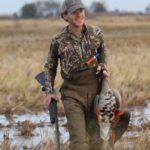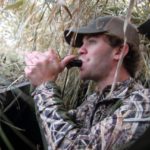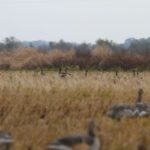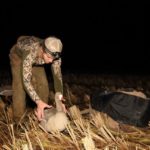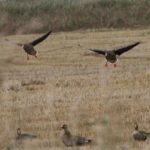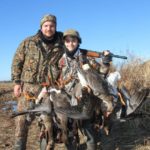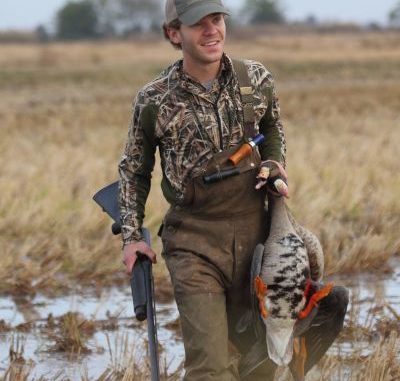
This world-class caller shares how to talk wary specklebelly geese into range, along with other tips to putting birds on the ground.
“If it doesn’t fire you up to see a group of specks come in your face, flying 15 yards over your head with their feet down — and you’re looking into their eyes and you see the bars light up in the sun — if that doesn’t fire you up, then you don’t need to be out here.”
I mulled those words around in my head while listening to Jack Cousin, a world champion white-fronted goose caller, who was hitting soft licks of clucks followed by enticing murmurs that had a group of about a half dozen birds on string coming toward us.
Cousin was literally backing up what I had just heard him say, because I was fired up.
Moreover, I was anxious as all get-out for the moment when he would tell me, “Shoot ’em!”
I first met Cousin when he was 14, and at the time he was taking duck-calling lessons from a retired dentist in New Iberia.
Now, here he was — a junior in college, 21 years old and all seasoned from guiding for Speckle Belly Hunting Club located just off of Highway 99 between Welch and Thornwell.
We reconnected through Facebook, when I friended a friend, who was his friend, and yada, yada, yada — so it goes. Social media continues to shrink the world.
Nonetheless, he’d become a real pro at waterfowl hunting in the rice fields, and his passion for it, particularly where specklebelly geese are concerned, grew exponentially.
Waterfowl language flows out of Cousin, and his calling has allowed him to win several state and national duck- and goose-calling honors. In 2013, he won the State Open “Meat” Duck Calling contest in Gueydan, and finished third in the world for specklebelly calling.
He followed that up the following year by winning the State Snow Goose Calling contest in Gueydan and the World Specklebelly calling contest in Texas.
He was making that experience count on this trip. Soon Cousin let his call slip out of his hand, which he moved to the forearm of his shotgun’s stock.
I anticipated the words with the geese right over the top of our heads.
“Shoot ’em,” said Cousin as he burst straight up out of the blind.
I picked out one goose I thought was closest to me and let go of both barrels of the Franchi over-and-under I was using.
Two birds splashed into the flooded rice field.
Once the birds were picked up and in the blind, what became quite apparent to my ear was what Cousin was doing in the field was “not” what he does in contests.
The world of contest calling in municipal auditoriums is not like the world of blinds in the marsh and rice fields.
“I’m a contest caller, and if I would see a group of specks out there and start running a contest routine, they’d laugh at me,” Cousin said. “It’s a different ballgame. You have to know what to do and when to do it.
“For example, when on the ground, specks do a lot of clucking that goes from a string of low to high notes. You can hear it. It goes up and down. Another thing they do is murmur on the ground.
“If you mix those two calls together and know when to do it, you’ll be very successful. A lot of guys just yodel at them. But, I do clucks most of the time because that is what they do most of the time.”
He’s also learned, by reading the behavior of white-fronted geese, that hunters shouldn’t do a lot of aggressive calling when birds are coming right at a blind. It’s only when they pass up a blind or are not looking like they’re going to break the right way that Cousin hits them a little harder with his call.
“You’ll want to get more excited with your clucks or calling,” he explained. “You’ll want to mix in some yodels, which is what they do when they are flying. With singles, a lot of times they will come in yodeling at you.
“All I’m doing then is just responding to them, going back and forth with them. I’m starting a conversation or dialogue with them. Most of the time that will do the trick. If not, then you mix in your clucks and ground murmur.”
Cousin’s clucks and murmurs got them committed to our blind, but what they saw also had a lot to do with it — especially when a flock dropped down into our decoy spread and landed.
Many outfitters in Southwest Louisiana feel that at the beginning of the season it only takes a few decoys to fool specklebelly geese.
Toward the end of the season, as the birds become wary and body up more, these guides put out upwards of two to three dozen dekes.
Cousin doesn’t add to his spreads.
“As far as numbers go, generally throughout the year I’ll hunt anywhere from six to maybe three dozen decoys,” he said. “During the middle of the season I’ll keep running two dozen until I think or see something that needs to be different.”
Placement is more important than numbers, he said.
“When putting them out, people have different opinions. Some place them bunched up in family groups, where others place them facing different directions,” Cousin said. “The one thing I think everyone can agree on is that you need to have decoys upwind of where you’re hunting.
“Having them upwind, if the specks do what they are supposed to do, they’ll finish up into the wind right over the top of the blind.”
He said downwind spreads can be counterproductive, with birds staying on the extreme outside edge of the dekes and more often than not passing or even landing beyond gun range.
Cousin recommended decoys be placed upwind approximately 30 to 50 yards from the blind.
He said decoys are like road blockers, with guides and outfitters using them to direct traffic to tell geese where to land or make their final pass.
Most guides and outfitters in the region also believe in using fully flocked full-body decoys, and Cousin is no different.
However, he said it’s also important for dekes to be good-looking, pointing out that specklebellies are very smart and recognize decoys that are less lifelike or old and faded.
“You need to have the best (decoys) for specks,” Cousin said. “I’ve been using Avery Greenhead Gear, but there are a few other good-looking decoys out there, like Blue Collar Decoys.
“But, whatever you use, it’s essential to have lifelike decoys. You have to be as real as possible with everything you do. Your calling, your decoys, your setup, your blind — everything — because they’ll pick you out in a heartbeat.”
Specklebelly Hunting Club owner Russell McNabb said his guides pay particular attention to concealment.
Like most rice-field hunters McNabb uses pit blinds buried along agricultural field levees. However, the first thing you’ll notice is these blinds have hinged lids, and woven into those lids are grasses found on the levee.
“We want to be part of the levee and look as natural as possible,” McNabb said. “We’re just not going to shoot at birds 35 or 40 yards away; we want to shoot them at 10 or 15 yards.
“So to do that you have to blend in so well the birds will finish feet down right over the top of the blind en route to your decoys upwind.”
With our two birds in the blind, it didn’t take long for another group of specklebellies to take notice of our field and be enticed by Cousin’s clucks and murmurs.
As with the first group, I couldn’t help but be anxious.
It boils down to everything in rice field country. The smells of the agricultural field, the northerly winds, the raucous sounds of not just white-fronted geese but snow and blue geese too, all add to the thrill of hunting this region.
When you add great calling skills, when birds overhead are in a conference call with someone in your blind, it’s a pretty amazing experience.
As the new gaggle of geese responded, they approached from behind our blind, slightly out of shotgun range. Cousin worked his Riceland Custom call, hoping to get the specks to make another pass.
Instead, they landed upwind, just beyond the decoys. We watched them milling about the decoys until one of the sentries spooked, and off they all went.
No worries. It was only 8 in the morning and it seemed the birds were just beginning to fly.
It was apparent we were in a pretty good flyway.
Due south below Highway 14 is Lacassine National Wildlife Refuge. To the southwest off of Highway 27 is Cameron Prairie National Wildlife Refuge. And to the southeast near Highway 91 rests White Lake Wildlife Conservation Area.
All of these Southwest Louisiana refuges make the surrounding agricultural rice field region attractive to ducks and geese.
Our third chance came when a group of about a half dozen specks decided to give us a look. Once again, Cousin carried on a conversation of yodels followed by his seductive clucks and murmurs.
It worked, and the geese turned and made a beeline for our blind.
They were close, with butts down, big orange feet sticking out and wings in an arc to break the wind as they glided over the top of our blind.
“Shoot ’em!” Cousin commanded.
And with that, it was over: We had our two-bird-per-man limit of specks.
“When I see a flock of birds, it’s like a math equation,” Cousin said. “When they don’t come close enough, I begin to think, ‘What do I need to do?’ Sometimes I think, ‘Did I hit them too hard with my calling? Do I need to hit them softer? Do they want to hear higher-pitch calling or lower pitch? Do they want to hear more clucks or yodels?’
“There are a ton of different variables that make you think. There’ll be days when you see them turn and their wings set, and you know you did something they like. That may work the rest of that day. Other days you can’t get them over the top. It’s really a never-ending question of solving, ‘Why didn’t that work and what can I do different?’”
After retrieving our birds, we picked up the decoys Cousin and I put out that morning, leaving the field empty and devoid of any human presence.
Editor’s note: Call Russell McNab at 337-304-9230 to book a hunt with Specklebelly Hunting Club.
